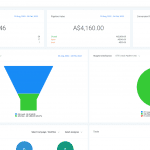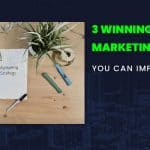If your business sells high-priced products or services, you’ve got to do more than just get the attention of potential customers—you need to gain their trust too…
And while that’s true for any business, the difference between influencing someone to spend $50 on an unknown brand compared to $350,000 on a new house is obviously huge!
When your business is selling products and services priced in the thousands, you’ve got to work harder for every sale.
You can’t rely on impulse buys to prop up your daily takings, and the customer journey is longer (and often far more complicated) than a lower cost item.
The New Buyer Journey
Coupled with this is the changing buyer journey. The way people make buying decisions has changed, and the buyer now has more information (i.e. power) than ever.
Customers no longer rely on salespeople or brands to get their information. They’re now better educated about the market and have different expectations from vendors.
They want the information they see as important to make a purchase decision, which doesn’t always align with what brands want to talk about.

Potential customers must feel complete confidence in your expertise and skill before they’ll buy, and they may take months or even years to reach a point where they’re ready to purchase.
As a business that sells high-priced services, we’ve seen first-hand just how effective a content marketing strategy can be for those with a long buyer journey. Our client stories are testament to this too, with one home builder growing from $8M to $26.3M in four years using our inbound marketing approach.

So if you’re looking for an effective long-term solution that will attract, nurture and win new customers, read on to learn more about how this approach works (and why it’s so effective for big ticket business).
The 3 Big Challenge for High-Ticket Businesses…
No matter which industry our clients belong to – from home builders and retirement/aged care, to tertiary educational and consultants – when they come to us, they all share some common challenges:
How do I attract more of my ideal customers earlier in their buyer journey?
How do I separate myself from my competitors and stop being just another price-based commodity?
How do I stay top of mind with prospects until they’re ready to buy?
For most, their approach up until this point was a combination of small scale marketing to attract leads, and then waiting for people to get in touch.
Their sales team would handle enquiries, spending a significant amount of time and effort in explaining and demonstrating the value of their product or service, then leave it with the customer to make a decision. And that was often the last they heard of them.
The customer would often shop around and find a cheaper price elsewhere. Or take the information you’ve given them and implement it themselves.
Without solid brand positioning, there is nothing separating you from your competitors and making you a “safe” choice, or a “must have”.

There’s no doubt the above strategy can win you some sales. But if you want to increase traffic, create leads and grow exponentially (not to mention free up your time in the process) a tested inbound marketing strategy will help you achieve your goals faster and more efficiently.
The reason for this lies in the holistic approach. It’s not just about getting your message out there about what you’re selling using content marketing — it’s about positioning yourself as a trusted authority.
The Solution to These Challenges is Content
By providing your audience with valuable content, not just once, but on a regular and ongoing basis, you help them in their decision-making and you showcase your expertise.
You’ll stay front of mind, and will most likely be the one they buy from when the time is right.
The ideal strategy should always be customised to suit, but will likely involve a combination of writing and promoting blog content, videos, email marketing, downloadable brochures or handbooks, case studies, social media posts, and paid amplification.
A lot of businesses are doing this already, but putting it together into a strategy that works is the key.:
How should all the pieces fit together?
How does the customer journey look for your specific business?
How educated about their problem are your customers when they find you?
These are all things you need to figure out before doing any tactics like SEO, paid ads, content, etc.
Once you’ve done some roadmapping of the customer journey, it’s a good idea to focus first on the areas that will have the biggest impact for the least effort. This could be as simple as creating a gated download to capture emails, and then build trust with an automated email sequence. Or it might be writing a fortnightly blog to boost SEO and expand your reach.
Timing and frequency will also need to be considered, as this will be dependent on the length of your sales cycle, your audience, product and budget.
Reaching the Right People
It’s one thing to write and publish great content that builds your brand and educates your prospect, but if you can’t get it in front of the right people at the right time, you’ll never gain the traction needed to make it all worthwhile.
This stems back to your personas, so if you haven’t identified these yet, it’s a critical first step. You’ll need an understanding of their characteristics, pain points and where they like to hang out online. Are they big on social media? If so, which platform and what time of day? Or do they prefer to conduct research online, reading blogs and longer form content to inform their buying decisions?
As you can see, how you deliver your content will depend on the preferences of your ideal customer, so spending time on getting this down first is a must. From there, you can share your content and messaging in different ways to ensure maximum reach.
It’s important to track and report on results using some sort of “single source of truth” platform (we use HubSpot), which will give you a clear picture of what’s working and where to make changes. This is another critical element of the strategy, as it allows us to refine the content and its delivery, and continually improve it.
Staying in Touch Throughout the Buyer Journey
If you’re a business with a long buyer journey, like most high-ticket businesses, you need a strategy to suit. It’s no good posting a blog article every few months, sending out a quarterly newsletter, or going weeks with no social media presence.
So too, every piece of content needs to have a “next step” associated with it. If you’re going to go to the effort of writing and promoting a blog post, you don’t want it just ending with “contact us for help”. You want it to lead to a natural middle of funnel related content offer that invites the ready to explore the topic further. This might be in the form of a free guide or cheat sheet.

To build the trust and engagement necessary to win more sales, you need to be publishing and promoting quality content on a regular basis. Consistency and quality are both non-negotiable if you’re serious about positioning yourself as an industry leader. If you’re sharing content that’s informative, relevant and addresses something your clients are struggling with or need to know, over time you’ll build a loyal readership and reputation for excellence.
In this way, building a client base who you can email with updates is hugely beneficial. Don’t be disheartened if you start small—as you continue to publish and distribute quality content it will grow. The important thing to remember is that when you’re selling an expensive product or service, depth is more important than breadth. In other words, you only need to attract a handful of buyers to move the needle, not thousands, so it’s fine to have a small audience of engaged contacts, rather than trying to be the next Tim Ferriss and growing a list of thousands.
You can accelerate this by including valuable gated content on your website. This could be a handbook, brochure, pricing guide, checklist or anything else that your potential customers may be willing to trade their email address for.
You can then send emails out weekly or fortnightly, as well as set up an automated sequence that’s triggered by specific behaviours, such as downloading a guide or pricelist.
Another tactic we use successfully with our clients is to “retarget” previous visitors to their sites – which means showing ads on external sites (news sites, social media, etc) based on the content they interacted with on your site.

A balance of new content, emails, ads and social media posts will keep the conversation going, and allow you to be there on the day they decide to make their purchase.
Reporting and Refining
Like anything in life and business, an effective strategy isn’t set in stone—it should be viewed as flexible, adaptable and ready to evolve and grow as your business demands. And to do this well, you’ll need regular and reliable data to guide your decisions.

To maximise the long-term benefits of digital marketing, a reporting system that can crunch the numbers and provide meaningful data on what’s working (and what’s not) is a game changer. In our own business we use HubSpot as an all-in-one platform for marketing and sales. The price can be a barrier for some, and it’s true that parts of the functionality can be done using cheaper software. However, when looking at ROI, keep in mind the extra time it will take to manage each individual platform and jump between them to track the various aspects, as well as bring it all together to get a clear overall picture.
Fast-tracking Your Growth
If you’re looking for a better way to promote your high-priced product or service, inbound and content marketing could be the ideal solution. While you can choose to DIY, partnering with a digital marketing agency like us frees up your time so you can focus on your business. On top of this, you’ll have an expert team looking after every aspect of your inbound marketing—from content strategy and creation, to social media posts and paid ads.
If our digital marketing approach sounds like something that could help you, apply for a free strategy session with our team to see if we can give you some direction and ideas.

- How Videos Can Be Used in Email Marketing for More Engagement - April 4, 2022
- Attention Home Builders: Here’s How to Educate, Engage and Win Over Potential Customers - October 19, 2020
- The Best Digital Marketing Framework for High Ticket Businesses - September 14, 2020




